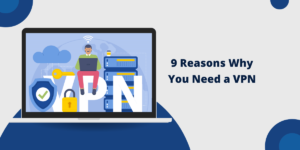Understanding the Basics of Site-to-Site VPN or Router-to-Router VPN
A site-to-site VPN, or router-to-router VPN, securely connects multiple networks over the internet by establishing an encrypted connection between them, allowing organizations across locations to share data and resources cost-effectively without expensive dedicated lines or leased circuits. Site-to-site VPNs link branch offices, data centers, cloud networks, and more, enabling private communication and cost savings.
This article examines how site-to-site VPNs work, their key benefits, and important factors for implementing and managing them, enabling networks to connect securely while reducing costs.
What is Site-to-Site VPN?
Site-to-Site VPN is one of the types of VPN that enables multiple private networks to securely connect and communicate over a public network like the internet. It is often used by businesses to link together regional offices, branch locations, and remote sites.
A Site-to-Site VPN creates a secure channel between two separate networks, enabling them to exchange information and utilize shared resources as if they were directly linked. All traffic flowing through the VPN tunnel is encrypted, obscuring the contents, and hiding the communication networks. This provides a secure and private connection across the public internet.
By using Site-to-Site VPN, businesses can connect their distributed network infrastructure while keeping all communications and data private. Remote offices can access central systems and share files as if on the same local network. Employees on different sites can collaborate easily while the VPN tunnel ensures their connectivity remains secure and isolated from external eavesdropping.
How does Site-to-Site VPN work?
The Site-to-Site VPN creates a protected tunnel between various networks to ensure secure transmission of data traffic, which is achieved by leveraging encryption techniques that make the data traffic unreadable to unauthorized parties. This secure connection enables seamless and safe flow of data traffic between the interconnected networks.
Here’s how Site-to-Site VPN works in detail:
- Authentication – The networks seeking to connect must first authenticate each other to verify their identity. This is done using a pre-shared key or digital certificates that prove the network ownership and permissions. Without proper authentication, a VPN tunnel will not be created.
- Tunnel establishment – Once authenticated, the networks negotiate the creation of an encrypted VPN tunnel between them. This tunnel encapsulates all the data transmitted between the networks in an extra layer of encryption for privacy. The tunnel endpoints are the security gateways connecting each network.
- Data encryption – Every packet of data sent through the VPN tunnel is encrypted using an agreed encryption algorithm like AES. This encryption obscures the contents and hides the communication, preventing unauthorized access. The encryption keys used are determined during the authentication and tunnel establishment steps.
- Routing – The encrypted data packets are then routed from one network to the other over the internet. The gateways at each end of the VPN tunnel handle decrypting the packets and forwarding them into the correct private network. Regular routing protocols direct the flow of encrypted VPN traffic across the public network.
- Security – The encryption, authentication, and encapsulation provide security by obscuring the existence and contents of the VPN communication. Only the authorized gateways with the correct keys can set up and maintain the VPN tunnel, thereby controlling access between the connected networks.
Benefits of Site-to-Site VPN
Here are the main benefits of a site-to-site VPN:
- Secure connectivity: A VPN encrypts all the data transmitted between the sites and hides the online activity from prying eyes. It provides a secure tunnel for communication.
- Remote access: Employees can securely access the resources and network of the main site from a remote location. This allows for greater flexibility and productivity.
- Seamless integration: A VPN makes the remote site feel like an extension of the main network. Users can access files, databases, printers, and other resources as if they are on the same local network.
- Cost savings: A VPN solution is often more cost effective than using leased lines or MPLS networks for connectivity between sites.
- Increased bandwidth: A VPN can utilize the available internet bandwidth to transmit data between sites. This provides faster speeds and the ability to run more bandwidth-intensive applications.
- Improved business continuity: With a VPN, the organization remains connected even if one network goes down. It provides redundancy and disaster recovery capabilities.
- Centralized management: IT administrators can implement network security policies, controls, and monitoring centrally across the connected sites. This simplifies network management.
- Smoother mergers and acquisitions: Integrating multiple sites under one VPN makes it easier to combine networks after an acquisition or merger.
- Enhanced mobility and collaboration: Employees can connect to the company network through the VPN even when working on the go on their mobile devices. This boosts productivity and teamwork.
- Greater scalability: It is easy to add or remove sites from a VPN as the business scales up or down. The VPN infrastructure is flexible and adaptable.
What are the Challenges of Site-to-Site VPN
Here are some common challenges associated with site-to-site VPN:
1. Complex setup
Setting up a VPN often requires technical expertise and can be complicated. It involves configuring networks, security protocols, encryption, authentication methods, and other settings correctly across multiple sites.
2. Latency issues
Although a VPN can utilize internet bandwidth, the connection is not as fast as a dedicated private network connection. This can lead to increased latency, lag, and slower performance of network-intensive tasks.
3. Vulnerability to threats
While a VPN provides encryption and Security, it still uses the internet as the medium of transmission. So the network is susceptible to threats like malware, man-in-the-middle attacks, and eavesdropping. Extra security measures are needed.
4. Limited bandwidth
The available bandwidth between sites connected over a VPN may be more constrained than on a dedicated network, especially over long distances. This can bottleneck network traffic and prevent large file transfers.
5. High costs
Although a VPN is often cheaper than leased lines in the long run, the initial setup fees for hardware, licensing, installation, and configuration services can be quite high. The ongoing costs of securing and managing the VPN also add up over time.
6. Poor user experience
Issues like latency, limited bandwidth, complex access methods, and security hurdles can negatively impact the productivity and experience of remote users connected over the VPN.
7. Difficult to monitor
Since the VPN rides on top of the internet, it is hard for IT admins to get granular visibility into network activity, performance, bandwidth utilization, security events, and other metrics needed to optimize the VPN.
8. Policy enforcement issues
It can be tricky to enforce consistent security policies, content filters, antivirus solutions, data loss prevention mechanisms, and other controls across a VPN network with multiple connected branches.
9. Lack of redundancy
If the internet connection fails at one of the connected sites, the whole VPN goes down, disabling connectivity and access to shared resources. Additional investments are required to set up a redundant VPN topology.
Final Thoughts
Site-to-Site VPNs securely connect networks in different locations and provide high data confidentiality, integrity, and availability over the internet. They create virtual tunnels between networks to encrypt and transmit traffic securely, scalable, flexibly, and cost-effectively, ideal for businesses of any size. Though complex to set up and manage, Site-to-Site VPNs with a skilled IT team ensure proper configuration and maintenance. Overall, Site-to-Site VPNs are a wise investment for businesses requiring secure connectivity across multiple sites.

 Verified A Professional Content Writer
Verified A Professional Content Writer
Riha Mervana is a professional content writer at SearchVPN.org, with extensive experience crafting engaging and informative content. She has established herself as an expert in the VPN industry, creating content that educates readers on the importance of online privacy and security.


